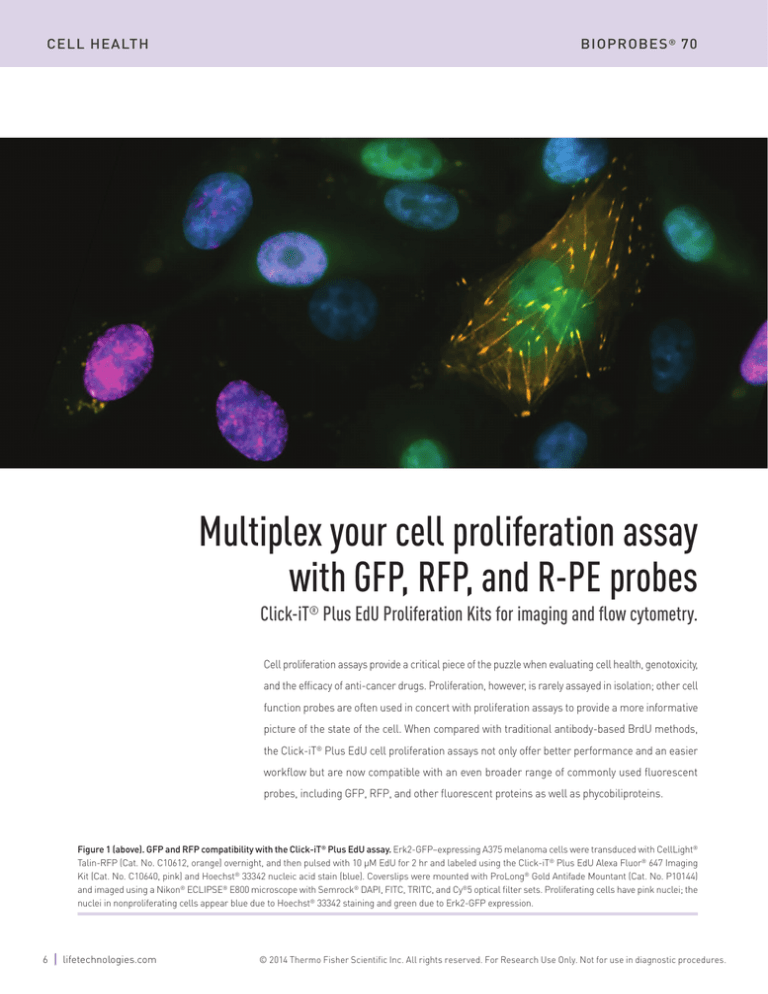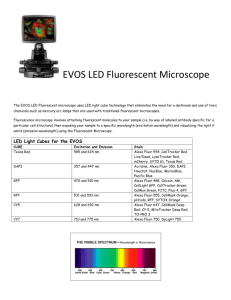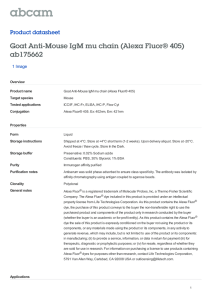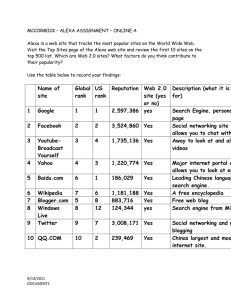
CELL HEALTH
BIOPROBES ® 70
Multiplex your cell proliferation assay
with GFP, RFP, and R-PE probes
Click-iT® Plus EdU Proliferation Kits for imaging and flow cytometry.
Cell proliferation assays provide a critical piece of the puzzle when evaluating cell health, genotoxicity,
and the efficacy of anti-cancer drugs. Proliferation, however, is rarely assayed in isolation; other cell
function probes are often used in concert with proliferation assays to provide a more informative
picture of the state of the cell. When compared with traditional antibody-based BrdU methods,
the Click-iT® Plus EdU cell proliferation assays not only offer better performance and an easier
workflow but are now compatible with an even broader range of commonly used fluorescent
probes, including GFP, RFP, and other fluorescent proteins as well as phycobiliproteins.
Figure 1 (above). GFP and RFP compatibility with the Click-iT® Plus EdU assay. Erk2-GFP–expressing A375 melanoma cells were transduced with CellLight®
Talin-RFP (Cat. No. C10612, orange) overnight, and then pulsed with 10 µM EdU for 2 hr and labeled using the Click-iT® Plus EdU Alexa Fluor® 647 Imaging
Kit (Cat. No. C10640, pink) and Hoechst® 33342 nucleic acid stain (blue). Coverslips were mounted with ProLong® Gold Antifade Mountant (Cat. No. P10144)
and imaged using a Nikon® ECLIPSE® E800 microscope with Semrock® DAPI, FITC, TRITC, and Cy®5 optical filter sets. Proliferating cells have pink nuclei; the
nuclei in nonproliferating cells appear blue due to Hoechst® 33342 staining and green due to Erk2-GFP expression.
6 | lifetechnologies.com
© 2014 Thermo Fisher Scientific Inc. All rights reserved. For Research Use Only. Not for use in diagnostic procedures.
BIOPROBES ® 70
CELL HEALTH
Click-iT® Plus EdU: A breakthrough cell proliferation assay
The Click‑iT® Plus EdU assay represents a significant breakthrough
in the evolution of cell proliferation measurements (Figure 1). The
most accurate cell proliferation assays directly quantitate newly
synthesized DNA by following the incorporation of a deoxyribonucleoside analog that contains a detectable tag. In the 1950s, the original
cell proliferation measurements were based on the incorporation of
radioactive nucleosides (i.e., 3H-thymidine) into DNA. Thirty years
later, a nonradioactive proliferation assay was introduced based
on the detection of the thymidine analog 5-bromo-2´-deoxyuridine
(BrdU) by anti-BrdU antibodies.
Although it eliminates the complications of working with
radioactivity, the BrdU proliferation assay is both difficult to perform consistently and time consuming, typically requiring 6–24 hr
to complete. In the standard BrdU assay, cells are incubated with
BrdU and then treated with acid, heat, or enzymes to denature the
DNA and facilitate detection of the incorporated BrdU molecules
Figure 3. Detection of cell proliferation and GFP fluorescence in mouse
tissue. A transgenic mouse was injected intraperitoneally with 50 µg EdU
per gram body weight 4 hr before sacrifice. The Click-iT® Plus EdU Alexa
Fluor® 555 Imaging Kit (Cat. No. C10638) was used to detect newly synthesized DNA in mouse duodenum tissue. Constitutively expressed ϐ‑actin–GFP
fusion (green) is seen in the smooth muscle band below the bright Click-iT®
Plus EdU–labeled proliferating cells (red) of the intestinal villi; the tissue
was counterstained with DAPI nucleic acid stain (blue). Image provided
by Jessica-Sordet Dessimoz, École Polytechnique Fédérale de Lausanne,
Lausanne, Switzerland.
by anti-BrdU antibodies (Figure 2A). These harsh treatments can
adversely affect cell morphology and antigen recognition sites, as
RFP, mCherry) or phycobiliproteins (e.g., R-PE, R-PE tandems),
well as image quality. The denaturants also limit the ability of the
which are regularly used in imaging or flow cytometry applications.
BrdU assay to be multiplexed with fluorescent proteins (e.g., GFP,
Unlike these traditional cell proliferation assays, the Click‑iT®
Plus EdU proliferation assay does not rely on radioactivity or antibodies for detection of the newly incorporated deoxyribonucleoside. In
A
the Click-iT® Plus EdU assay, the alkyne-containing thymidine analog
B
Anti-BrdU
antibody
Inaccessible
without
denaturation
X
EdU (5-ethynyl-2´-deoxyuridine) is incorporated into DNA during
Click-iT® Plus
Alexa Fluor®
picolyl azide
active DNA synthesis [1]. The incorporated EdU is then detected by a
click reaction—a copper-catalyzed azide–alkyne cycloaddition—using
Accessible
a fluorescent Alexa Fluor® or Pacific Blue™ dye containing a picolyl
azide moiety (Figure 2B). The use of the picolyl azide combined with
a copper protectant is the basis of the upgraded Click-iT® Plus EdU
technology, which achieves the same sensitive, reliable detection
of cell proliferation as the original Click-iT® EdU assay while also
preserving the fluorescence of GFP, RFP (Figures 1, 3, and 4), and
R-PE. Standard aldehyde-based fixation and detergent permeabi-
Figure 2. Detection of incorporated BrdU with an anti-BrdU antibody,
compared with detection of incorporated EdU with the Alexa Fluor® picolyl
azide. (A) Without DNA denaturation, BrdU is inaccessible to antibodies used
for detection. (B) The small size of the EdU detection reagent, Alexa Fluor®
picolyl azide, eliminates the need to denature the DNA for the detection
reagent to access the nucleotide.
lization are sufficient for the Click‑iT® Plus EdU detection reagent
to gain access to the DNA; no harsh denaturants are required. The
click reaction and subsequent wash steps are typically completed
in 60 minutes, and newly synthesized DNA can be detected and
quantified using image-based techniques or flow cytometry.
© 2014 Thermo Fisher Scientific Inc. All rights reserved. For Research Use Only. Not for use in diagnostic procedures.
lifetechnologies.com | 7 CELL HEALTH
BIOPROBES ® 70
A
B
C
BrdU (8 msec)
BrdU (80 msec)
Click-iT® Plus EdU (8 msec)
Figure 4. Cell proliferation detected using the BrdU assay or the Click-iT® Plus EdU assay. (A, B) After incubation with BrdU, Erk2-GFP–expressing A375
melanoma cells were treated with HCl, resulting in a loss of GFP signal, and incubated with Alexa Fluor® 594 anti-BrdU antibody (clone MoBU-1, Cat. No.
B35132), producing moderately bright detection of proliferation (red), shown here with (A) an 8 msec exposure and (B) an 80 msec exposure. (C) In contrast,
Erk2-GFP A375 cells processed using the reagents and fixation/detection protocol provided in the Click-iT® Plus EdU Alexa Fluor® 594 Imaging Kit (Cat. No.
C10639) retained their GFP signal (green), and the EdU-based detection of proliferation was very bright (red, 8 msec exposure). Both cell samples were treated
with Hoechst® 33342 nucleic acid stain (blue); high-content analysis was performed using the Thermo Scientific® Cellomics® ArrayScan® VTI HCS Reader.
Choose Click-iT® Plus EdU assays over BrdU assays
To demonstrate its superior performance, the Click-iT® Plus EdU
the BrdU proliferation signal required a 10-fold longer exposure
assay was directly compared with the traditional BrdU assay. The
time (Figure 4B) to generate results comparable to those obtained
proliferation signal from A375 melanoma cells expressing an Erk2-
with the Click-iT® Plus EdU assay (Figure 4C).
GFP fusion was detected using either BrdU or Click-iT® Plus EdU
(Figure 4). The harsh treatment required for the antibody-based
Multiplex Click-iT® Plus EdU assays with fluorescent proteins
BrdU assay resulted in the loss of the GFP signal, as seen by the
The ability to multiplex Click-iT® Plus EdU assays with other fluo-
absence of green fluorescence in Figures 4A and 4B. Furthermore,
rescent probes opens the door to a more complete analysis of cell
function. For example, Figure 1 shows proliferating A375 melanoma
cells that are expressing both GFP and RFP fusion proteins; addi-
104
GFP+/EdU–
GFP+/EdU+
tionally, the red-fluorescent talin-RFP fusion protein confirms the
GFP fluorescence
presence of an intact cytoskeletal structure. New DNA synthesis
and GFP expression were also detected by fluorescence microscopy
103
in tissue samples from a transgenic mouse model (Figure 3) and
102
by flow cytometry in Erk2-GFP–expressing A375 melanoma cells
(Figure 5). In addition, mCherry fluorescence was preserved when
101
mCherry-expressing A549 cells were assayed for cell proliferation
–
–
–
GFP /EdU
100
100
GFP /EdU
101
102
103
+
104
Click-iT® Plus EdU Alexa Fluor® 647 fluorescence
Figure 5. Dual-parameter plot of fluorescence from cells labeled with the
Click-iT® Plus EdU Alexa Fluor® 647 Flow Cytometry Assay Kit and GFP.
Erk2-GFP–expressing A375 melanoma cells were treated with 10 μM EdU for
2 hr and detected according to the Click-iT® Plus EdU staining protocol (Cat.
No. C10634). Data were collected and analyzed using the Attune® Acoustic
Focusing Cytometer with 635 nm excitation and a 660/20 nm bandpass emission filter for detection of the Alexa Fluor® 647–labeled EdU, and with 488 nm
excitation and a 530/30 nm bandpass emission filter for detection of GFP.
8 | lifetechnologies.com
using the Click-iT® Plus EdU Alexa Fluor® 488 Kit (Figure 6).
Likewise, phycobiliproteins (e.g., R-PE and R-PE tandems)
can be multiplexed with Click-iT® Plus EdU cell proliferation
assays. Figure 7 shows co-labeling of Jurkat cells with Click-iT®
Plus Alexa Fluor® 488 picolyl azide to detect incorporated EdU
and with PE-Cy®7–conjugated mouse anti–human CD4 antibody.
This dual-parameter flow cytometry experiment demonstrates the
preservation of the phycobiliprotein fluorescence as well as of the
antigen recognition sites on the primary antibody.
© 2014 Thermo Fisher Scientific Inc. All rights reserved. For Research Use Only. Not for use in diagnostic procedures.
BIOPROBES ® 70
CELL HEALTH
C
Number of cells
Click-iT® Plus EdU
Alexa Fluor® 488 fluorescence
B
Number of cells
A
102
103
104
105
102
Click-iT® Plus EdU
Alexa Fluor® 488 fluorescence
103
104
105
105
104
103
102
0
mCherry fluorescence,
Click-iT® Plus EdU conditions
50
100
150
200
250
FxCycle™ Far Red fluorescence
Figure 6. Flow cytometric analysis of mCherry-expressing cells labeled with the Click-iT® Plus EdU Alexa Fluor® 488 Flow Cytometry Assay Kit and FxCycle™
Far Red Stain. mCherry-expressing A549 cells were treated with 10 µM EdU for 2 hr and detected according to the Click-iT® Plus EdU staining protocol (Cat.
No. C10632). (A) Cells in S phase are identified by the fluorescence of the Alexa Fluor® 488-labeled EdU. (B) mCherry fluorescence is readily detected in cells
under the conditions used for Click-iT® Plus EdU labeling and is not significantly different from that seen in the no-copper positive control (data not shown).
(C) Dual-parameter plot of Alexa Fluor® 488–labeled EdU fluorescence (indicating newly synthesized DNA) and FxCycle™ Far Red Stain fluorescence (indicating
DNA content analysis, Cat. No. F10348). This plot’s typical inverted U-shaped pattern identifies proliferating cells with bright EdU staining and nonproliferating
cells with dim EdU staining that are either in G0/G1 phase (with 2N DNA content) or in G2/M phase (with 4N DNA content).
Even more Click-iT® Plus tools
In addition to the imaging and flow cytometry kits, the Click-iT®
protectant. They allow you to optimize your own Click-iT® Plus
Plus technology is available in the Click-iT® Plus Alexa Fluor®
detection of alkyne-containing biomolecules in vitro, in cells, or
Picolyl Azide Toolkits, which contain the reagents needed to
in tissue samples.
perform copper-catalyzed click reactions with copper-sensitive
compounds. These toolkits provide Alexa Fluor® picolyl azide and
Learn about the latest advances in Click-iT® Plus technology
Click-iT® reaction buffers, as well as copper sulfate and copper
The Click-iT® Plus technology advances our original Click-iT®
protocols and offers more flexibility for multiplexing with
Hu CD3 PE-Cy®7 fluorescence
other cell function assays. Find out more about the Click-iT®
106 CD3+/EdU–
+
+
CD3 /EdU
Plus technology and upcoming Click-iT® Plus products at
105
lifetechnologies.com/clickitplusbp70. ■
104
Reference
1. Salic A, Mitchison TJ (2008) Proc Natl Acad Sci U S A 105:2415–2420.
103
102
1
10
CD3–/EdU–
101
102
CD3–/EdU+
103
104
105
106
Click-iT® Plus EdU Alexa Fluor® 488 fluorescence
Figure 7. Dual-parameter plot of fluorescence from cells labeled with the
Click-iT® Plus EdU Alexa Fluor® 488 Flow Cytometry Assay Kit and the
PE-Cy®7 anti–Hu CD3 antibody. Jurkat cells were treated with 10 μM EdU
for 2 hr, stained with the PE-Cy®7 conjugate of anti–Hu CD3 antibody (Cat.
No. MHCD0312), and detected according to the Click-iT® Plus EdU staining
protocol (Cat. No. C10632). Data were collected and analyzed using the
Attune® Acoustic Focusing Cytometer with 488 nm excitation and a 530/30 nm
bandpass emission filter for detection of the Alexa Fluor® 488–labeled EdU,
and with 488 nm excitation and a 780/60 nm bandpass emission filter for
detection of the PE-Cy®7 anti–Hu CD3 conjugate.
Product
Quantity
Cat. No.
Click-iT® Plus EdU Alexa Fluor® 488 Imaging Kit
1 kit
C10637
Click-iT® Plus EdU Alexa Fluor® 555 Imaging Kit
1 kit
C10638
Click-iT® Plus EdU Alexa Fluor® 594 Imaging Kit
1 kit
C10639
Click-iT® Plus EdU Alexa Fluor® 647 Imaging Kit
1 kit
C10640
Click-iT Plus EdU Alexa Fluor 488 Flow Cytometry
Assay Kit
50 assays
C10632
100 assays
C10633
Click-iT® Plus EdU Alexa Fluor® 647 Flow Cytometry
Assay Kit
50 assays
C10634
100 assays
C10635
Click-iT Plus EdU Pacific Blue Flow Cytometry
Assay Kit
50 assays
C10636
Click-iT® Plus Alexa Fluor® 488 Picolyl Azide Toolkit
1 kit
C10641
Click-iT® Plus Alexa Fluor® 555 Picolyl Azide Toolkit
1 kit
C10642
Click-iT® Plus Alexa Fluor® 647 Picolyl Azide Toolkit
1 kit
C10643
®
®
®
© 2014 Thermo Fisher Scientific Inc. All rights reserved. For Research Use Only. Not for use in diagnostic procedures.
™
lifetechnologies.com | 9


![Mouse IgG2b, kappa monoclonal [7E10G10] - Isotype](http://s2.studylib.net/store/data/012909847_1-9b2bb6a95a189600a77028a367bfe36d-300x300.png)


![Anti-CD147 antibody [EPR4053] (Alexa Fluor® 488) ab205450](http://s2.studylib.net/store/data/012963350_1-9f029359b62a58420c39721f185df4dd-300x300.png)
![Anti-BNIP3 antibody [ANa40] (Alexa Fluor® 647) ab196706](http://s2.studylib.net/store/data/012083394_1-2ff7db27c0d6912ecfc1f982c1a7d990-300x300.png)
![Mouse IgG1, kappa monoclonal [15-6E10A7] - Isotype](http://s2.studylib.net/store/data/013010303_1-392570c3e54d2e1fe03f81061feadb91-300x300.png)